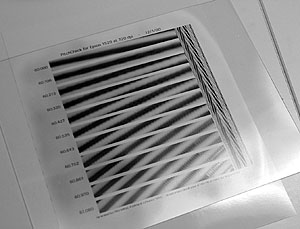|
Determining
the Pitch
Now
that we have a print of a series of eleven slightly different pitchcheck
strips, we need to determine which strip will match our lens.
Lay
the print on a flat surface, and lay the lens on top of the print.
If the lens will not lay flat, then set a heavy piece of flat glass
on top of the lens.
Align
the lens to the print by looking at the vertical stripes on the
right side of the image.

By
examining the lines on the right side of the print, you can determine
when the lens is perfectly aligned to the print.

This
is not properly aligned...

Nor
is this..

Now
we're aligned.
Once
properly aligned it becomes apparent that many of these pitch strips
are not going to work. They are banded and it is obvious that these
will be eliminated.
Actually
there will be only one, or perhaps two lines that will work.
WE
ARE LOOKING FOR THE LINE THAT "FLASHES" FROM BLACK TO
WHITE!
Dragging
the movie control of the above Quicktime movie, left and right,
will simulate what you would see with this pitch check file by moving
your head left and right. Notice that I find it easier to view these
with one eye closed. Move very slowly and pay very close attention
to both the left and right sides of the image. We need to find
one strip that flashes from black to white entirely... all at once.
It doesn't roll... it doesn't crawl... it flashes or flips. Although
these all turn white and all turn black at one moment or another...
they don't all flash.
Only
the fifth line from the top does what we want... this would be our
pitch... for this lens... on this printer... on this material...
today!
It
may all change tomorrow.
|

